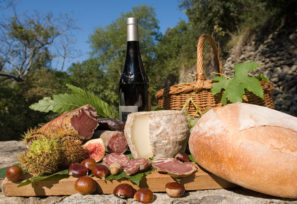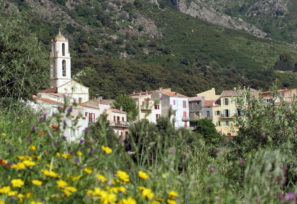Open the gates …
In the Corsican language, I Cateri literally means gates. We invite you to come and open them, one by one, to finally discover what is hiding behind them. Firstly, you will catch a glimpse of the ancient granite houses which border the narrow streets of the village. If you wander around the paved streets and through the archways, you will arrive at the piazzetta. It is from this village square which overlooks the sea, that your voyage of discovery begins.
Cateri, a preferred spot for craftspeople…
Cateri will open the gates to the very well-hidden garden and unveil its secrets. You can begin your visit at Virginie Bareille‘s KINAI workshop. This place is perfectly situated between the sea and the mountains and it is here that this artist uses her imagination to create objects of art. Here you can also meet another passionate craftsman who creates handmade decorative tiles.
One-of-a-kind religious heritage…
Now head towards the Church of Santa Maria Assunta. Do you feel like you’ve been here before? It’s possible… It is believed that this church was built using the plans for Saint Peter’s Cathedral in Rome. Look up at the remarkable apse and bell tower, the only one of its kind in Corsica, then go inside… You will come face to face with two particularly remarkable 17th-century paintings.
Nearby, you will find the Chapel of the Saint Marcelle brotherhood. Go inside just for a moment to admire the painting of Isaac’s sacrifice.
A spiritual halt…
Then, as you are leaving the village of Cateri, look down below the road towards Lavatoggio. You will see a convent built onto the ruins of the castello de Marcassu which dates back to the 10th century. Today it is used by the Benedictine religious institutes of the Notre-Dame d’Espérance congregation. Some very lucky people even get to enter this place for polyphonic concerts in the summer.
A gourmet break…
After a spiritual and artistic experience, now it’s time to taste some local delights!
An absolute must in Cateri is to stop by Chez Léon. Another major place for traditional fine-dining and celebrations is the U San Dumè inn which offers copious homestyle cooking, using maquis herbs and with a festive atmosphere. The biscuit factory in the village is also a must-see, for ancient family recipes and the famous cuggiole with almonds or white wine.
Did you know?
Between Cateri and Lavatoggio, there is a bridge called Ponte di a Spusata. According to popular tradition, its name comes from a young bridge who lost her life here when she was leaving on her honeymoon, in a horse and carriage, with her new husband.
Cateri in pictures
le village de Cateri
House in Cateri
the village of Cateri
A Chapel in Cateri








